Growth hormone receptor is a protein that in humans is encoded by the GHR gene. [5] GHR orthologs [6] have been identified in most mammals.
Growth hormone receptor is a protein that in humans is encoded by the GHR gene. [5] GHR orthologs [6] have been identified in most mammals.
Growth hormone receptor (GHR) is a transmembrane protein consisting of 620 amino acids. The receptor is part of the Type I cytokine receptor family of receptors. GHR exists in two forms as a full length membrane-bound receptor and as a soluble GH binding protein (GHBP). [7] [8] GHR contains two fibronectin type III β domains in its extracellular domain, whereas the intracellular domain contains tyrosine Kinase JAK2 binding sites for SH2 proteins. JAK2 is the primary signal transducer for growth hormone. [9]
This gene encodes a protein that is a transmembrane receptor for growth hormone. [10] [11] Binding of growth hormone to the receptor leads to reorientation of a pre-assembled receptor dimer dimerization (the receptor may however also exist as monomers on the cell surface [12] ) and the activation of an intra- and intercellular signal transduction pathway leading to growth. [13] A common alternate allele of this gene, called GHRd3, lacks exon three and has been well characterized. Mutations in this gene have been associated with Laron syndrome, also known as the growth hormone insensitivity syndrome (GHIS), a disorder characterized by short stature (proportional dwarfism). Other splice variants, including one encoding a soluble form of the protein (GHRtr), have been observed but have not been thoroughly characterized. [5] Laron mice (that is mice genetically engineered to carry defective Ghr), have a dramatic reduction in body mass (only reaching 50% of the weight of normal siblings), and also show a ~40% increase in lifespan.

Growth hormone receptor has been shown to interact with SGTA, [15] PTPN11, [16] [17] Janus kinase 2, [18] [19] [20] Suppressor of cytokine signaling 1 [21] and CISH. [21]
The GHR gene is used in animals as a nuclear DNA phylogenetic marker. [6] The exon 10 has first been experienced to explore the phylogeny of the major groups of Rodentia. [22] [23] [24] GHR has also proven useful at lower taxonomic levels, e.g., in octodontoid, [25] [14] arvicoline, [26] muroid, [27] [28] murine, [29] and peromyscine [30] rodents, in arctoid [31] and felid [32] carnivores, and in dermopterans. [33] Note that the GHR intron 9 has also been used to investigate the mustelid [34] and hyaenid [35] carnivores phylogenetics.
Growth hormone receptor antagonists such as pegvisomant (trade name Somavert) are used in the treatment of acromegaly. [36] They are used if the tumor of the pituitary gland causing the acromegaly cannot be controlled with surgery or radiation, and the use of somatostatin analogues is unsuccessful. Pegvisomant is delivered as a powder that is mixed with water and injected under the skin. [37]

Signal transduction is the process by which a chemical or physical signal is transmitted through a cell as a series of molecular events. Most commonly, protein phosphorylation is catalyzed by protein kinases, ultimately resulting in a cellular response. Proteins responsible for detecting stimuli are generally termed receptors, although in some cases the term sensor is used. The changes elicited by ligand binding in a receptor give rise to a biochemical cascade, which is a chain of biochemical events known as a signaling pathway.

Insulin-like growth factor 1 (IGF-1), also called somatomedin C, is a hormone similar in molecular structure to insulin which plays an important role in childhood growth, and has anabolic effects in adults.
Steroid hormone receptors are found in the nucleus, cytosol, and also on the plasma membrane of target cells. They are generally intracellular receptors and initiate signal transduction for steroid hormones which lead to changes in gene expression over a time period of hours to days. The best studied steroid hormone receptors are members of the nuclear receptor subfamily 3 (NR3) that include receptors for estrogen and 3-ketosteroids. In addition to nuclear receptors, several G protein-coupled receptors and ion channels act as cell surface receptors for certain steroid hormones.

Estrogen receptors (ERs) are a group of proteins found inside cells. They are receptors that are activated by the hormone estrogen (17β-estradiol). Two classes of ER exist: nuclear estrogen receptors, which are members of the nuclear receptor family of intracellular receptors, and membrane estrogen receptors (mERs), which are mostly G protein-coupled receptors. This article refers to the former (ER).
In biology, cell signaling is the process by which a cell interacts with itself, other cells, and the environment. Cell signaling is a fundamental property of all cellular life in prokaryotes and eukaryotes.
The prolactin receptor (PRLR) is a type I cytokine receptor encoded in humans by the PRLR gene on chromosome 5p13-14. It is the receptor for prolactin (PRL). The PRLR can also bind to and be activated by growth hormone (GH) and human placental lactogen (hPL). The PRLR is expressed in the mammary glands, pituitary gland, and other tissues. It plays an important role in lobuloalveolar development of the mammary glands during pregnancy and in lactation.

The insulin-like growth factor 1 (IGF-1) receptor is a protein found on the surface of human cells. It is a transmembrane receptor that is activated by a hormone called insulin-like growth factor 1 (IGF-1) and by a related hormone called IGF-2. It belongs to the large class of tyrosine kinase receptors. This receptor mediates the effects of IGF-1, which is a polypeptide protein hormone similar in molecular structure to insulin. IGF-1 plays an important role in growth and continues to have anabolic effects in adults – meaning that it can induce hypertrophy of skeletal muscle and other target tissues. Mice lacking the IGF-1 receptor die late in development, and show a dramatic reduction in body mass. This testifies to the strong growth-promoting effect of this receptor.

The follicle-stimulating hormone receptor or FSH receptor (FSHR) is a transmembrane receptor that interacts with the follicle-stimulating hormone (FSH) and represents a G protein-coupled receptor (GPCR). Its activation is necessary for the hormonal functioning of FSH. FSHRs are found in the ovary, testis, and uterus.

The luteinizing hormone/choriogonadotropin receptor (LHCGR), also lutropin/choriogonadotropin receptor (LCGR) or luteinizing hormone receptor (LHR), is a transmembrane receptor found predominantly in the ovary and testis, but also many extragonadal organs such as the uterus and breasts. The receptor interacts with both luteinizing hormone (LH) and chorionic gonadotropins and represents a G protein-coupled receptor (GPCR). Its activation is necessary for the hormonal functioning during reproduction.

Tyrosine-protein phosphatase non-receptor type 11 (PTPN11) also known as protein-tyrosine phosphatase 1D (PTP-1D), Src homology region 2 domain-containing phosphatase-2 (SHP-2), or protein-tyrosine phosphatase 2C (PTP-2C) is an enzyme that in humans is encoded by the PTPN11 gene. PTPN11 is a protein tyrosine phosphatase (PTP) Shp2.
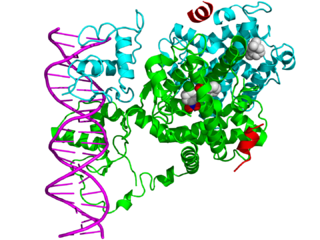
In the field of molecular biology, nuclear receptors are a class of proteins responsible for sensing steroids, thyroid hormones, vitamins, and certain other molecules. These intracellular receptors work with other proteins to regulate the expression of specific genes thereby controlling the development, homeostasis, and metabolism of the organism.
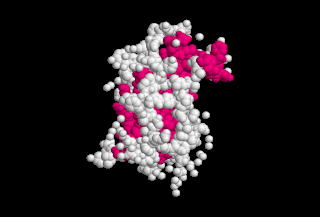
Laron syndrome (LS), also known as growth hormone insensitivity or growth hormone receptor deficiency (GHRD), is an autosomal recessive disorder characterized by a lack of insulin-like growth factor 1 production in response to growth hormone. It is usually caused by inherited growth hormone receptor (GHR) mutations.
Growth hormone-binding protein (GHBP) is a soluble carrier protein for growth hormone (GH). The full range of functions of GHBP remains to be determined however, current research suggests that the protein is associated with regulation of the GH availability and half-life in the circulatory system, as well as modulating GH receptor function.

Growth hormone secretagogue receptor(GHS-R), also known as ghrelin receptor, is a G protein-coupled receptor that binds growth hormone secretagogues (GHSs), such as ghrelin, the "hunger hormone". The role of GHS-R is thought to be in regulating energy homeostasis and body weight. In the brain, they are most highly expressed in the hypothalamus, specifically the ventromedial nucleus and arcuate nucleus. GSH-Rs are also expressed in other areas of the brain, including the ventral tegmental area, hippocampus, and substantia nigra. Outside the central nervous system, too, GSH-Rs are also found in the liver, in skeletal muscle, and even in the heart.
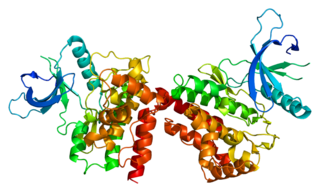
Janus kinase 2 is a non-receptor tyrosine kinase. It is a member of the Janus kinase family and has been implicated in signaling by members of the type II cytokine receptor family, the GM-CSF receptor family, the gp130 receptor family, and the single chain receptors.

The growth-hormone-releasing hormone receptor (GHRHR) is a G-protein-coupled receptor that binds growth hormone-releasing hormone. The GHRHR activates a Gs protein that causes a cascade of cAMP via adenylate cyclase. GHRHR is distinct from the growth hormone secretagogue receptor, where growth hormone releasing peptides act to release growth hormone.
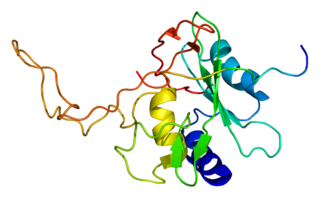
Suppressor of cytokine signaling 3 is a protein that in humans is encoded by the SOCS3 gene. This gene encodes a member of the STAT-induced STAT inhibitor (SSI), also known as suppressor of cytokine signaling (SOCS), family. SSI family members are cytokine-inducible negative regulators of cytokine signaling.

Signal transducer and activator of transcription 5A is a protein that in humans is encoded by the STAT5A gene. STAT5A orthologs have been identified in several placentals for which complete genome data are available.

John Kopchick is a molecular biologist and co-inventor of the drug Somavert (Pegvisomant), which has improved the lives of acromegalic individuals around the world. He is currently the Goll-Ohio Eminent Scholar and Professor of Molecular Biology in the Department of Biomedical Sciences at the Ohio University Heritage College of Osteopathic Medicine. Dr. Kopchick's groundbreaking work in the field of growth hormone has helped shape the study of endocrinology.
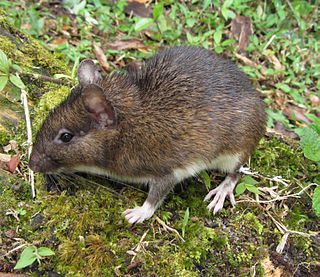
Euryzygomatinae is a subfamily of rodents, proposed in 2017, and containing three extant genera of spiny Echimyidae: Clyomys, Euryzygomatomys, and Trinomys.